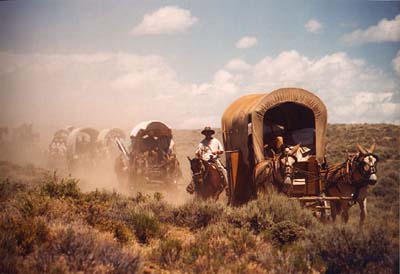|
California Gold Rush 1849 - 1852
Many Cherokee Indians, living in Oklahoma because of the forced relocation over the Trail of Tears in 1838, also headed west. They were expreienced miners from their earlier years in North Carolina and Georgia and were unhappy with conditions in Oklahoma. They pioneered the Cherokee Trail across Oklahoma, through Colorado and into southern Wyoming before joining onto the main California Trail. Initial migration started in 1849; peak overland migration was in 1852 the same year as a severe cholera epidemic in the eastern United States. In all some 400,000 people traveled to California in search of gold. |
All rights reserved. For details and contact information: See License Agreement, Copyright Notice. |
 On January 24, 1848, workers found gold while cutting lumber at Sutter's Mill on the South Fork of the American River. The discovery led to the gold rush of 1849, when thousands of "49ers" made their way to California seeking fortunes. The vast majority went by sea around Cape Horn, at first, and later across the Isthmus of Panama. About 30,000 headed overland, following the routes forged in 1841 by the Bidwell- Bartleson Party, and by subsequent travelers including Lansford Hastings and the Donner-Reed parties of 1846. However, many overland emigrants took other trails, including the Old Spanish Trail that crossed New Mexico.
On January 24, 1848, workers found gold while cutting lumber at Sutter's Mill on the South Fork of the American River. The discovery led to the gold rush of 1849, when thousands of "49ers" made their way to California seeking fortunes. The vast majority went by sea around Cape Horn, at first, and later across the Isthmus of Panama. About 30,000 headed overland, following the routes forged in 1841 by the Bidwell- Bartleson Party, and by subsequent travelers including Lansford Hastings and the Donner-Reed parties of 1846. However, many overland emigrants took other trails, including the Old Spanish Trail that crossed New Mexico.